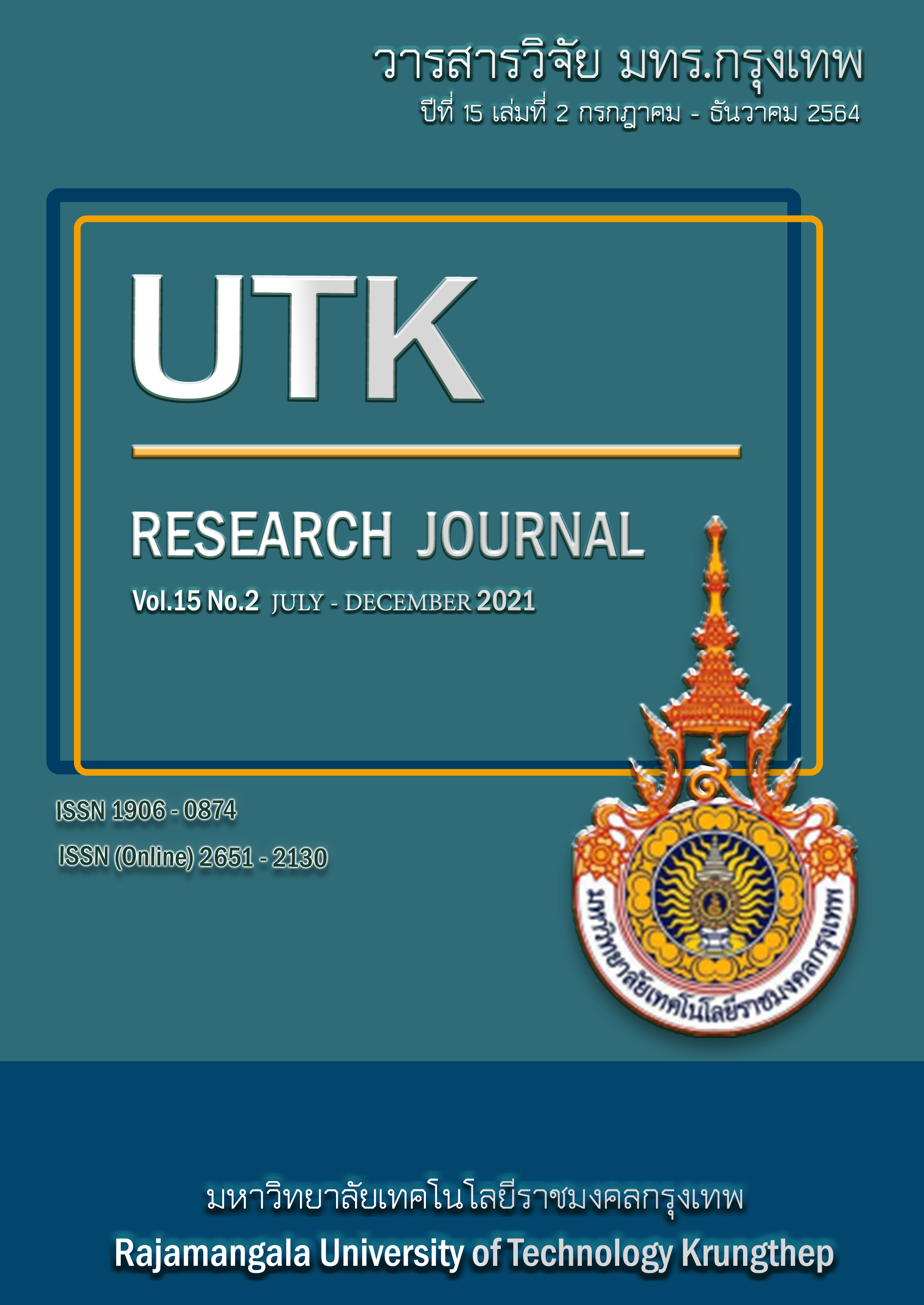rotein Digestion Efficiency of Papain Enzyme Crude Extract from Papaya Byproduct
Keywords:
Papain enzymes, Crude extracts, PapayaAbstract
This research was investigated the efficiency of proteins digestion of crude extracts, papain enzymes from papaya byproduct. By extracting crude extracts, papain enzymes from papaya peels and seeds variety of Khaek Dum, then determined the amount of crude extract to the weight of papaya byproduct, pH, the amount of papain enzymes in the crude extract incoulding the efficiency of protein digestion in the texture and protein content. It was found that the amount of crude extract from papaya peels and papaya seeds were 5.76 g/100 g and 8.92 g/100 g, respectively. The amount of papain enzymes in crude extracts from papaya peels and papaya seeds were 130.36 and 167.48 mg/ml, and pH values were 5.56 and 5.53 respectively. The efficiency of protein digestion was influenced by texture from the shear force of pork marinated with crude extract, papain enzymes from papaya peels and papaya seeds for 30, 45 and 60 min. The results found that shear forces of pork marinated with crude extract, papain enzymes from papaya peels and papaya seeds used were 128.75, 119.24, 11.35 and 98.97, 91.68, 85.49 N, respectively. The softer pork used lower shear forces for cutting because of the enzymes from papaya were high effective on digesting proteins. The protein content from the protein degradation of pork marinated with crude extracts papain enzymes, from papaya peels and papaya seeds for 30, 45 and 60 min were 0.442, 1.021, 1.604 and 0.610, 1.354, 2.105 mg/mL, respectively. The protein content was increased when increased marinated time. The efficiency of protein digestion of crude extracts, papain enzyme from the papaya seeds were higher than the papaya peels.
References
You L, Zhao M, Liu RH, et al. Antioxidant and antiproliferative activitiesof loach (Misgurnus anguillicaudatus) peptides prepared by papain digestion. J Agr Food Chem. 2010;14:7948-53.
Sullivan GA and Calkins CR. Application of exogenous enzymes to beef muscle of high and low connective tissue. Meat Science J. 2010;85:730-4.
Abdel-Naeem HHS and Mohamed HHM. Improving the physico - chemical and Sensory characteristics of camel meat burger patties using ginger extract and papain. Meat Science J. 2016;118:52-60.
Kristinsson HG. Aquatic food protein hydrolysates. In: Maximising the Value of Marine By Products. Cambridge Woodhead, UK; 2006.
Fernandez J, Castaneda D and Hormigo D. New trends for a classical enzyme:papain, a biotechnological success story in the food industry. Journal Food Science and Technology. 2017;68:91–101.
Kim DC, Cahe HJ and In MJ. Existence of stable fibrin clotting inhibitor in salt fermented anchovy sauce. Journal Food Compos Anal. 2004;17:113-8.
Erdmann K, Cheung WY and Schroder H. The possible roles of food derived bioactive peptides in reducing the risk of cardiovascular diseases. J Nutr Biochem. 2008;19:643–54.
Giannini MJ, Coleman M and Innerfiled I. Antithrombin activity in Homocystinuria. The Lancet J.1975;305:1090-4.
Ninfa A, Ballou D and Benore M. Fundamental Laboratory Approaches for Biochemistry and Biotechnology. John Wiley & Sons Inc. 2010.
Esti M, Benucci I, Lombardelli C, et al. Papain from papaya (Carica papaya L.) fruit and latex : Preliminary characterization in alcoholic-acidic buffer for wine application. J Food Biop Process.2013;91:595-8.
Konno K, Hirayama C, Nakamura M, et al. Papain protects papaya trees from herbivorous insects: role of cysteine proteases in latex. The Plant J. 2004;37: 370-8.
Abdulazeez SS, Ramamoorthy B, Ponnusamy P. Proximate analysis and production of protein hydrolysate from king fish of Arabian gulf coast - Saudi arabia. Int J Pharm Bio Sciences. 2013;3: 138-44.
Downloads
Published
How to Cite
Issue
Section
License
กองบรรณาธิการวารสารวิชาการ มหาวิทยาลัยเทคโนโลยีราชมงคลกรุงเทพ มีความยินดีที่จะรับบทความจากอาจารย์ นักวิจัย นักวิชาการทั้งภายในและภายนอกมหาวิทยาลัย ในสาขาวิชาวิทยาศาสตร์และเทคโนโลยี ได้แก่ สาขาวิชาวิทยาศาสตร์ วิศวกรรมศาสตร์ และสาขาอื่นๆ ที่เกี่ยวข้อง รวมถึงสาขาต่างๆ ที่มีการบูรณาการข้ามศาสตร์ที่เกี่ยวข้องวิทยาศาสตร์และเทคโนโลยี ที่เขียนเป็นภาษาไทยหรือภาษาอังกฤษ ซึ่งผลงานวิชาการที่ส่งมาขอตีพิมพ์ต้องไม่เคยเผยแพร่ในสิ่งพิมพ์อื่นใดมาก่อน และต้องไม่อยู่ในระหว่างการพิจารณาของวารสารอื่น
การละเมิดลิขสิทธิ์ถือเป็นความรับผิดชอบของผู้ส่งบทความโดยตรง บทความที่ได้รับการตีพิมพ์ต้องผ่านการพิจารณากลั่นกรองคุณภาพจากผู้ทรงคุณวุฒิและได้รับความเห็นชอบจากกองบรรณาธิการ
ข้อความที่ปรากฏอยู่ในแต่ละบทความที่ตีพิมพ์ในวารสารวิชาการเล่มนี้ เป็นความคิดเห็นส่วนตัวของผู้เขียนแต่ละท่าน ไม่เกี่ยวข้องกับมหาวิทยาลัยเทคโนโลยีราชมงคลกรุงเทพแต่อย่างใด ความรับผิดชอบด้านเนื้อหาและการตรวจร่างบทความแต่ละบทความเป็นของผู้เขียนแต่ละท่าน หากมีความผิดพลาดใดๆ ผู้เขียนแต่ละท่านจะต้องรับผิดชอบบทความของตนเองแต่ผู้เดียว
กองบรรณาธิการขอสงวนสิทธิ์มิให้นำเนื้อหา หรือข้อคิดเห็นใดๆ ของบทความในวารสารวิชาการ มหาวิทยาลัยเทคโนโลยีราชมงคลกรุงเทพ ไปเผยแพร่ก่อนได้รับอนุญาตจากกองบรรณาธิการ อย่างเป็นลายลักษณ์อักษร ผลงานที่ได้รับการตีพิมพ์ถือเป็นลิขสิทธิ์ของวารสาร






